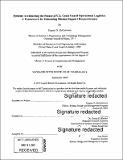Systems architecting the future of U.S. Coast Guard operational logistics : a framework for enhancing mission support responsiveness
Author(s)
McGuinness, Eugene D.
Download1341998511-MIT.pdf (87.13Mb)
Other Contributors
Massachusetts Institute of Technology. Engineering Systems Division.
System Design and Management Program.
Advisor
Donna H. Rhodes.
Terms of use
Metadata
Show full item recordAbstract
Enterprises that are successful over the long term are compelled to continuously transform in order to adapt to complexity and challenges. Often, many of these transformation efforts fail to achieve the desired future state objectives. The United States Coast Guard (USCG) initiated a major modernization effort over a decade ago that created a Mission Support enterprise responsible for acquiring and maintaining the complex surface, aviation, shore, and IT assets and systems while supporting workforce readiness to conduct both planned and contingency operations. Within the modernization milestones, the Director of Operational Logistics (DOL), Logistics and Service Centers, and regional Bases were established to provide a single point of accountability to the field. After several years of operating in this construct, several barriers still obstruct the Mission Support enterprise from achieving integrated, customer-centric, optimized delivery of operational logistics. This thesis argues that a "systems approach" to architecting the enterprise can posture Mission Support to enhance responsiveness to operational demands. The thesis applies the Architecting Innovative Enterprise Strategies (ARIES) Framework as the methodology for demonstrating the systems approach to leveraging complex enterprise interfaces for desired value delivery. Use of the seven step ARIES process model illustrates that a new enterprise architecture can be conceived, evaluated, and selected from a set of generated alternatives. This future state architecture is required to align resources, communication, and coordination for required levels of service delivery to achieve strategic enterprise and Service goals. The process activities provide a holistic approach to architecting an enterprise, identifying key drivers for change, detailing the envisioned future, recommending a "To-Be" architecture of best fit for desired outcomes, and prescribing an implementation plan that will most effectively and efficiently transform the enterprise. This research and subsequent findings provide USCG Mission Support leadership with a glide path to transform the DOL, Logistics and Service Centers, and Bases into an integrated and responsive enterprise for delivery of operational logistics in both contingency and steady state paradigms.
Description
Thesis: S.M. in Engineering and Management, Massachusetts Institute of Technology, Engineering Systems Division, System Design and Management Program, 2019 Cataloged from PDF version of thesis. "DISCLAIMER: Views expressed in this thesis are those of the author and do not reflect the official policy or the position of the United States Coast Guard, the Department of Homeland Security, or the United States Government"--Disclaimer page. Includes bibliographical references (pages 153-158).
Date issued
2019Department
Massachusetts Institute of Technology. Engineering Systems Division; System Design and Management Program.Publisher
Massachusetts Institute of Technology
Keywords
Engineering Systems Division., System Design and Management Program.